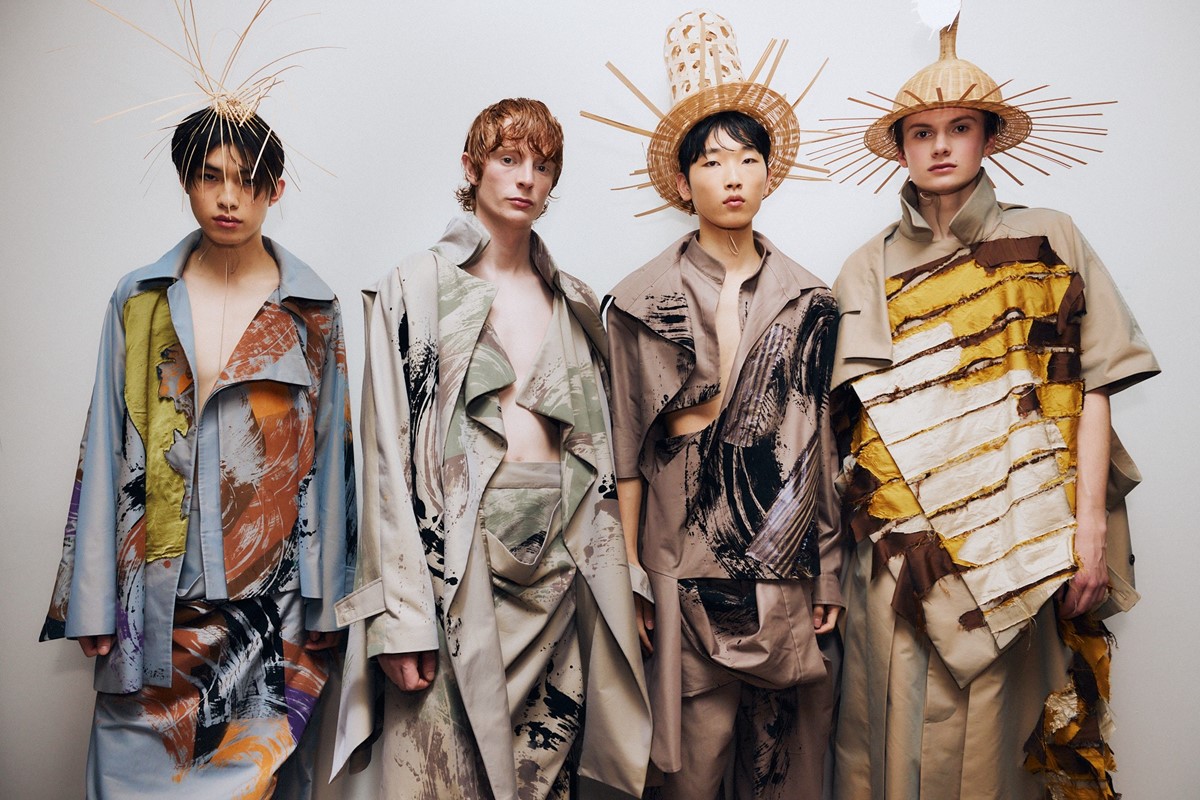
Rewrite
Central Saint Martins MA Fashion 2025 – Part 144 Images
By now, you don’t need a reminder of why Central Saint Martins’ MA show is an important one on the calendar. The birthplace of countless design legends (Philo, Galliano, McQueen, etc), the university’s annual Masters showcase attracts one of the biggest and most fervent crowds at London Fashion Week, concluding the opening night of the schedule with a mammoth show of 18 collections, 140 looks and guests packed to the rafters. From lads in tea towels, to lunatic office sirens and blown-up Y-fronts, last night’s show had it all – so scroll down for eight of the best collections to have on your radar now.
Central Saint Martins MA Fashion 2025 – Part 245 Images
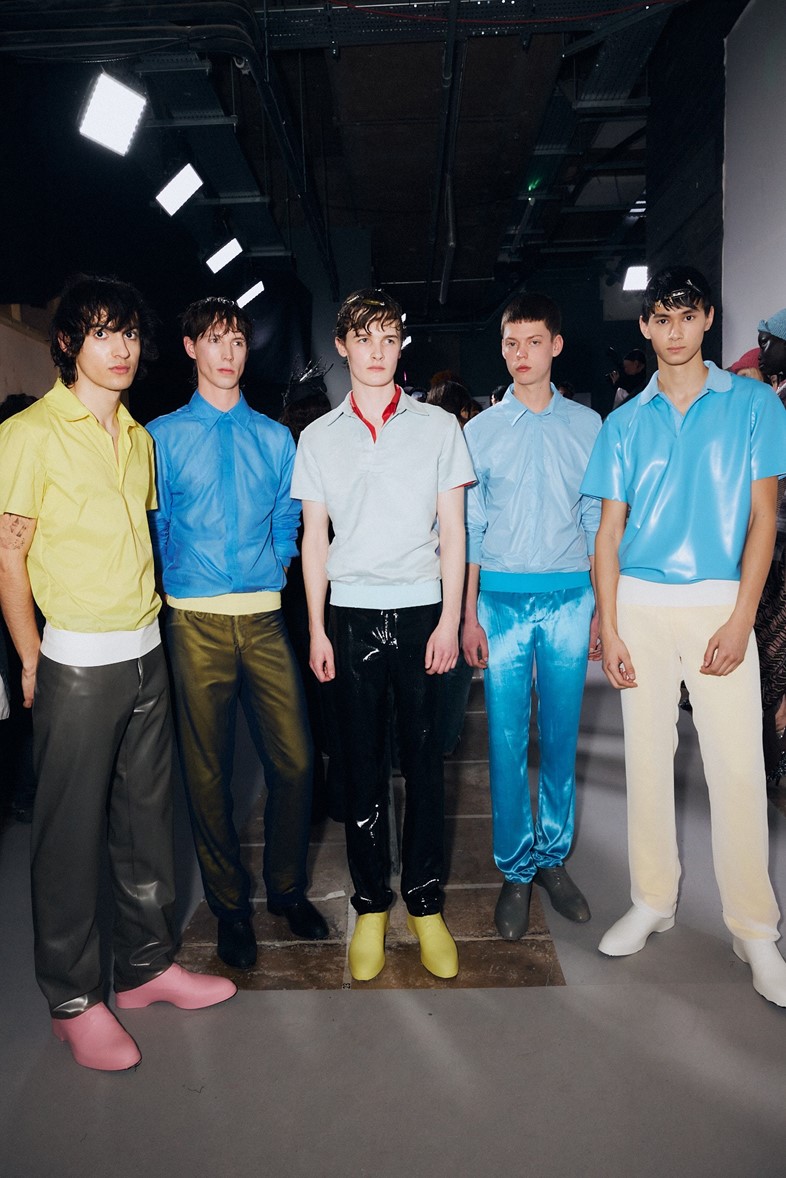
Alison Keogh and Kate Dewar met on the BA Fashion course at CSM and got on so well they decided to team up for their Masters degrees. “We did the second year group project in BA, where you either hate everyone you work with or you actually find something that works,” said New Zealand-born Keogh backstage, “and we’re just best friends!”
The pair’s collection shone on the runway for its uncanny simplicity, in that the clothes were quotidian, but rendered in unexpected fabrications that instantly elevated them to fashion. “We essentially started off with mundane everyday garments, and kind of wanted to take menswear into a surreal, hyperrealistic world through fabrication and colour,” said Scot Kate Dewar of the collection’s starting point. After gathering their references, the pair churned their research through an AI blender that produced glossy, high-shine outfits, then they went about recreating those as faithfully as they could. As a result, polo shirts were created in sky blue latex, silk trousers pooled at uncanny, latex-covered shoes, while plastic bangles were made to look like buttoned shirt cuffs. With those accessories, and the collection as a whole, Dewar added that the duo were “playing with the idea of what’s real and what isn’t, because we started off with research that was super ordinary, and turned it into like really odd imagery.”
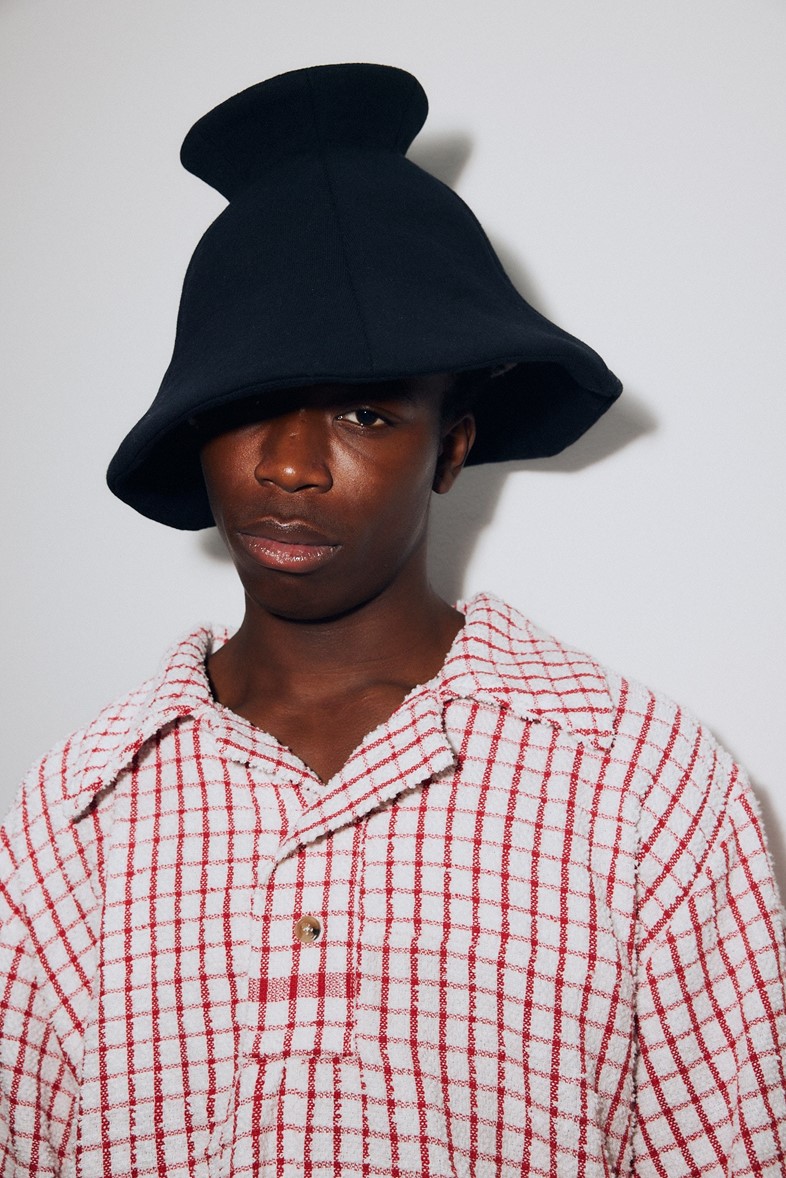
British Fashion Council scholar and resident lad William Palmer also debuted his collection on Thursday night, where his aim was to present a “carefree and sensitive kind of guy” through playful subversions of Great British staples. Chequered teatowels were repurposed into baggy skater boy shirts, a waxy picnic blanket became a cagoule, a red teapot was a man-bag and teacups were transformed into bucket hats. “I’m very interested in lad culture,” Palmer told us backstage, “so I like reworking ‘lad’ garments with a funny twist.”
The designer – who used to work at Commes des Garçons – also parodied the financial pressures put on millennial and Gen Z men with his ‘breadwinner’ concept, sending a huge duffel bag in the shape of a loaf of bread down the runway, a big bite taken out of it to symbolise capitalist greed. Elsewhere, a businessman in a trench coat looked like he’d had the back of his boxer shorts hiked over his head, but it was actually an all-in-one wedgie playsuit. “I was drawing parallels between adolescence and adulthood with the wedgie,” said Palmer. “How kids assert dominance in the playground, and how that translates into the working world.” And it’s not only the BFC that Palmer has on side – last night he was announced as one of the winners of the L’Oréal Professionnel Award at the end of the show, finding out just before he had to his runway lap. “I’m actually so overwhelmed I didn’t know how to react,” he told us, afterwards. “I never win anything!”
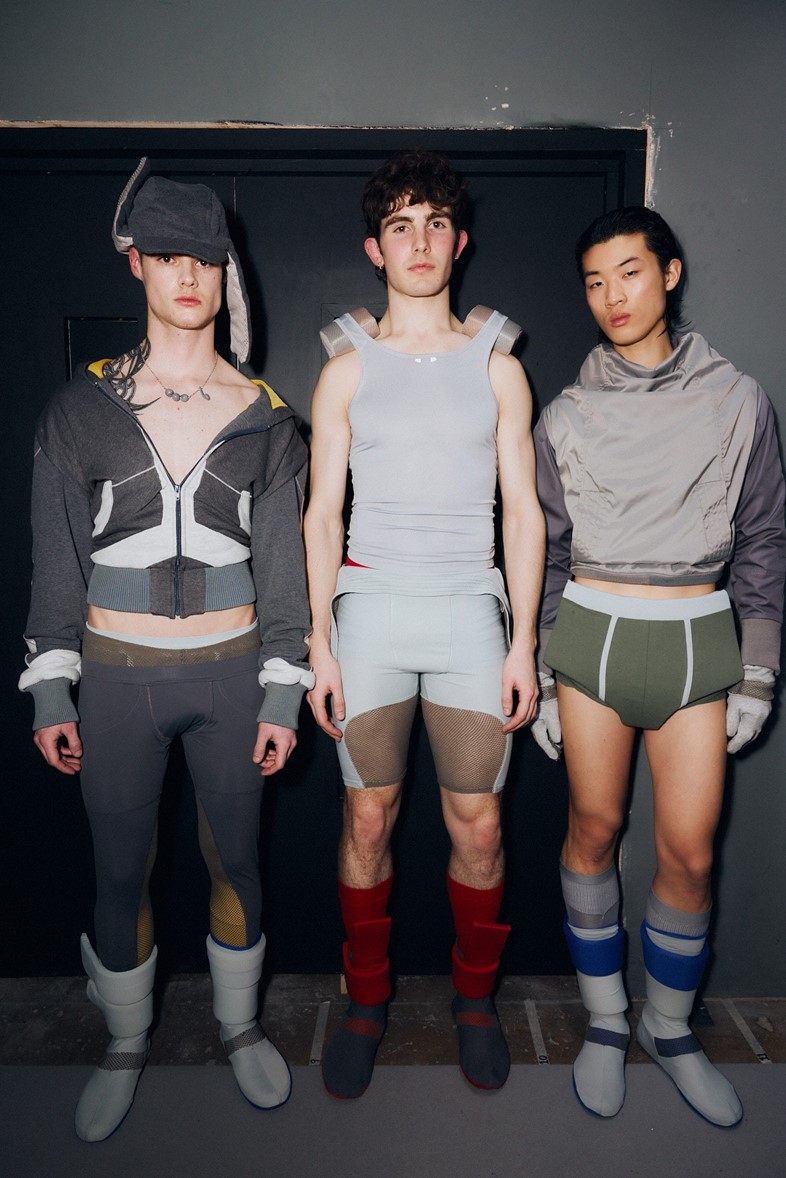
“The collection is about trying to find joy in the future that feels a bit uncertain,” Jake Zhang told us after the show’s finale. “It’s about how we all have these digital escapes, like video games, cartoons. Instead of trying to escape with them, how do we bring them into the everyday?” At the show, Zhang brought those references into the everyday, by presenting avatars straight from a screen. Cropped sweaters and panelled hoodies emphasised action figure proportions, while floppy, cartoonish hats were placed on some models’ heads.
Along with the digital references, the collection was also referencing a kind of queer masculinity and desire, encoded in the scally sweatpants, bare chests and tight micro shorts. One garment that made everyone at the show reach into their trousers and whip out their iPhones was a pair of blown-up padded, Y-fronts, snapped on like Polly Pocket’s clothes. “They were inspired by old boxing shorts,” said Zhang, of the pair. “Vintage sportswear – particularly vintage boxing and bodybuilding – is so that man who is attractive without being intimidating. There’s something so camp and queer about him, even though he’s totally, probably straight.”
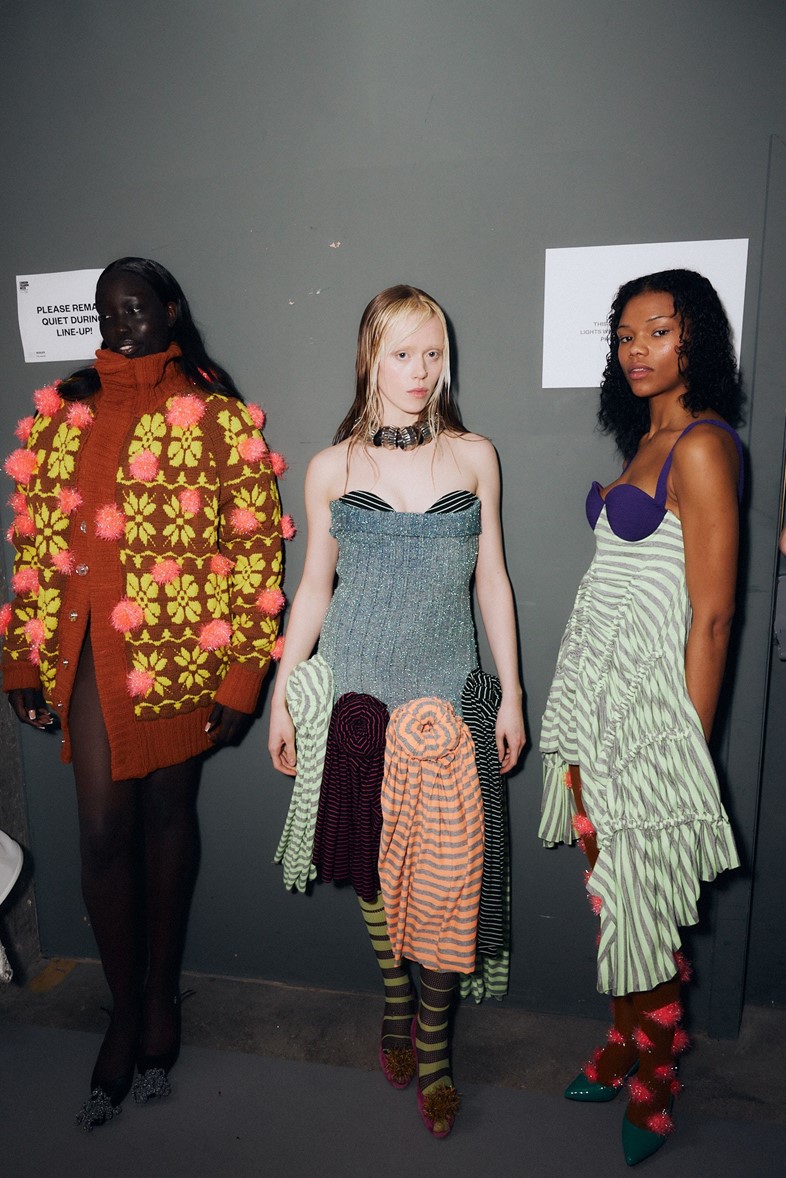
A Central Saint Martins fashion show is never short of its madcap, kaleidoscopic moments, and Scar Kennedy was on hand to provide the goods this year. The Leicestershire native’s MA collection Personality Hire was an absurd take on the office siren trend that has seemed to dominate our feeds for the last couple of years. “She’s kind of an office siren, but also like a lunatic,” the designer said of the Scar Kennedy woman. “She’s a menace to society, she’s chaotic, colourful, and tried to reflect that [in the collection].”
On the catwalk, a bulging, burnt orange Fair Isle cardigan was adorned with glittery pom poms, as were the maroon tights and peep-toe heels. A striped dress seemed to be distorted by ruching, but Kennedy had actually stitched old telephone cords into the fabric to give it a warped effect. Though she’s had stints working with Paulina Russo and Alicia Robinson of AGR Knit, Kennedy’s most immediate influence is eclectic Northerner Matty Bovan, who she described as “one of my biggest mentors” backstage.
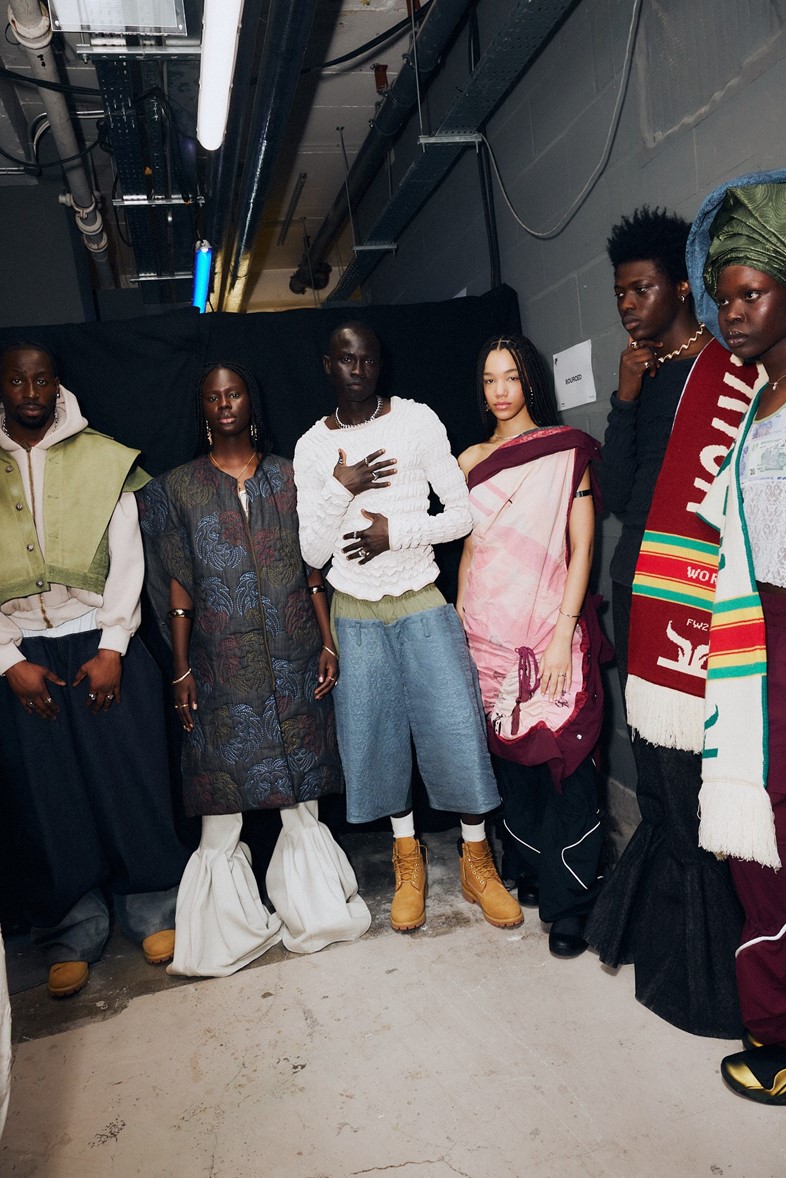
New York native Kelechi Mpamaugo swapped the advertising world for the halls of CSM, having worked as an art director for brands like adidas and Ford before taking up her MA. Her LFW collection, Home and World, was inspired by a dual Black American and Nigerian heritage and the “constant movement between these worlds”. On the catwalk, signifiers from both cultures were spliced into hybrid avatars and offered up as a harmonious fusion. A model wearing a gele – a traditional Nigerian headdress – wore maroon cargo pants and gold sneakers below, while a bomber jacket was slashed into the shape of an agbada, a type of West African robe.
Elsewhere, double-sided football scarves draped across shoulders referenced both Igbo robes and America’s sporting culture, while a New Yorker in classic Timbs wore a pair of cargo shorts that had their own built-in sag. “The collection explores how tradition and modernity coexist within me and within so many others,” Mpamaugo told us. “From the deep-rooted traditions of West African dress, to the cool and athleticism embedded in Black American style, this collection is a tribute to the ways we navigate, adapt, and shape culture globally.”
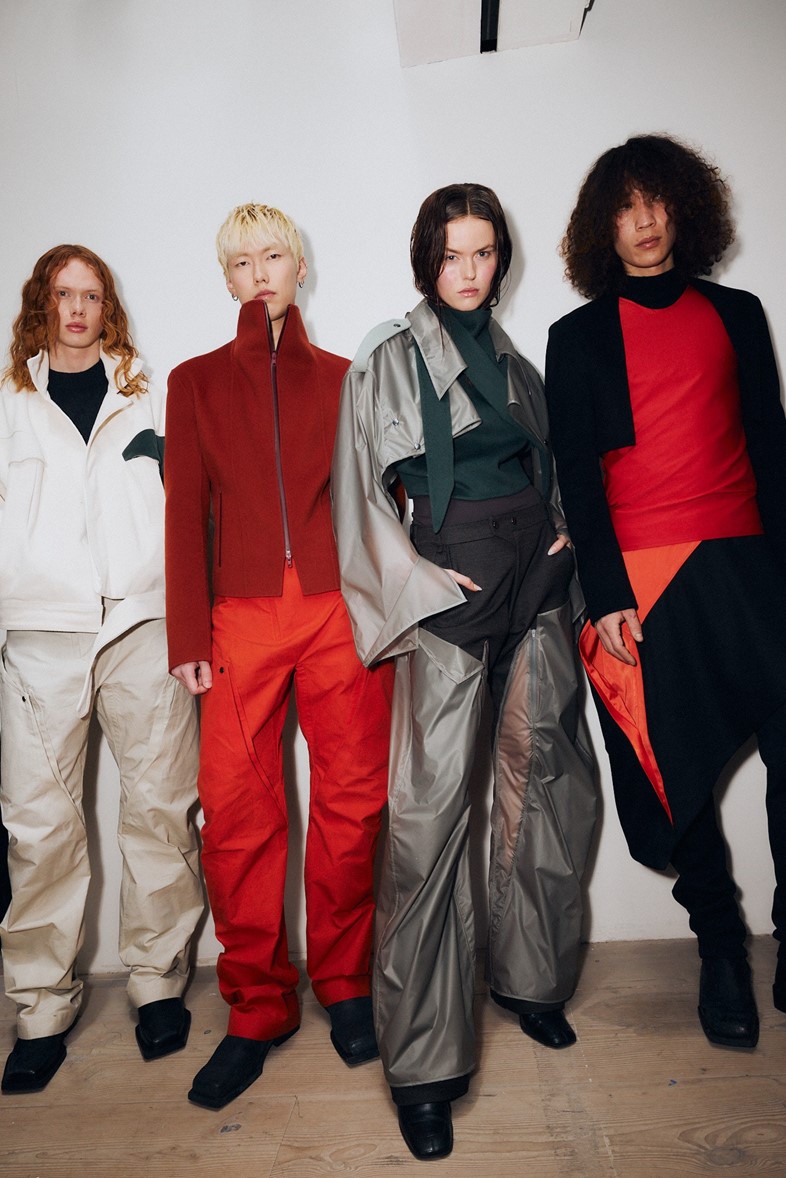
After joining straight from the Fashion Design BA, Jane Fu’s debuted an MA collection centred on “the figure of the ‘hunter’ – someone who seeks, explores, and pursues.” A technical collection inspired by her native Inner Mongolia and its nomadic culture, Fu also added that the offering “world-builds around urban space as the new artificial nature, revealing a hybrid of urban tailoring and outdoor apparel.”
A model in a grey felt, panelled jacket appeared on the runway first, followed by more models in angular garments made of lightweight tech fabric. Though small, the collection was an expert combination of complicated construction and structured simplicity, with some garments made of composite shapes and fabrications, while others came unadorned. A standout were the padded cargo trousers with pop-out panels, which are sure to catch the eye of Stone Island, who offered Fu a job before she decided to go for the MA instead.
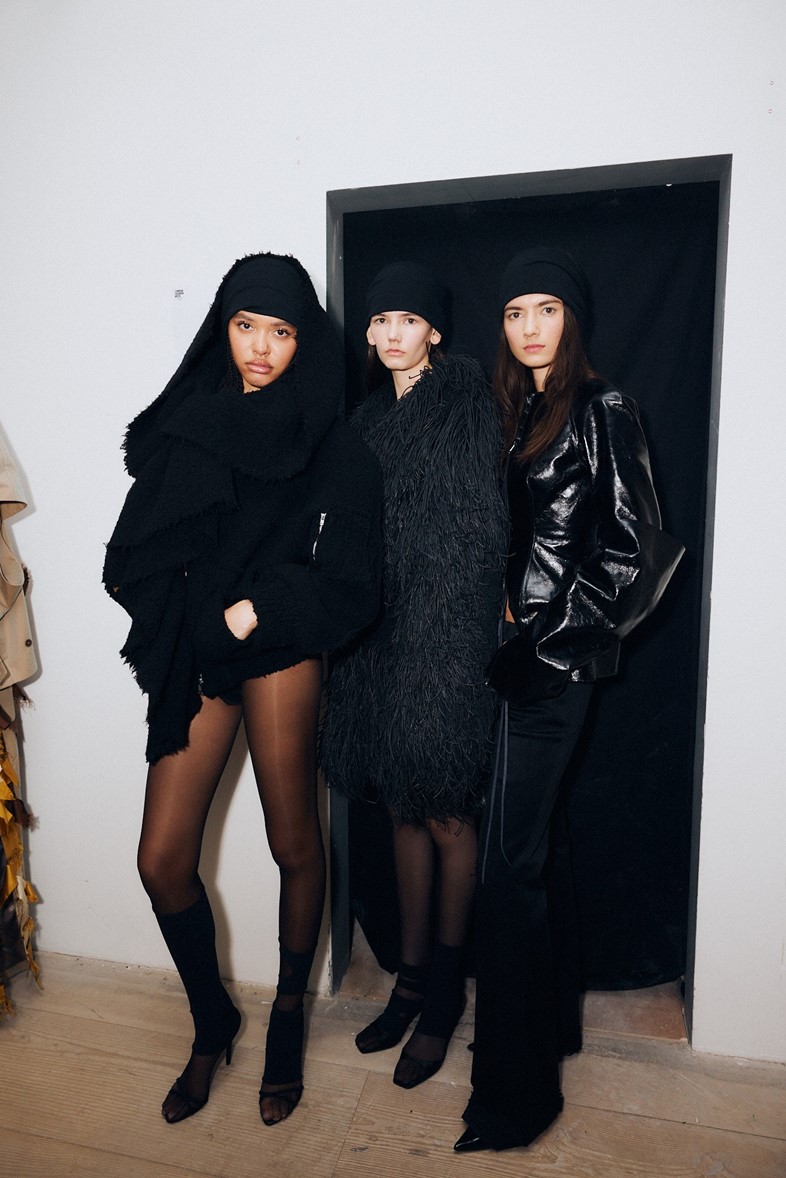
Last summer, designer Lucas Moretti had been reading SCUM Manifesto by Valerie Solanas and The Faggots & Their Friends Between Revolutions by Larry Mitchell. Those blistering, feminist declarations came to influence Moretti’s MA collection we saw last night, which was centred on his aesthetic rendering of the “motherly figure”. But, in Moretti’s world, the mother is a chic figure dressed in all black, whether that be hooded knitwear, a sequined gown, or a greatcoat constructed from wax cord strings. “Coming from Geneva, going to London, it was quite a shock,” said the designer. “It was really important for me to surround myself with female figures that could really empower me and also be friends and be mothers without being my mother.” Elsewhere in the collection, the wax strings reappeared as a handbag, while black wellies were repurposed into imposing, cunty heels. How can you not say mother!
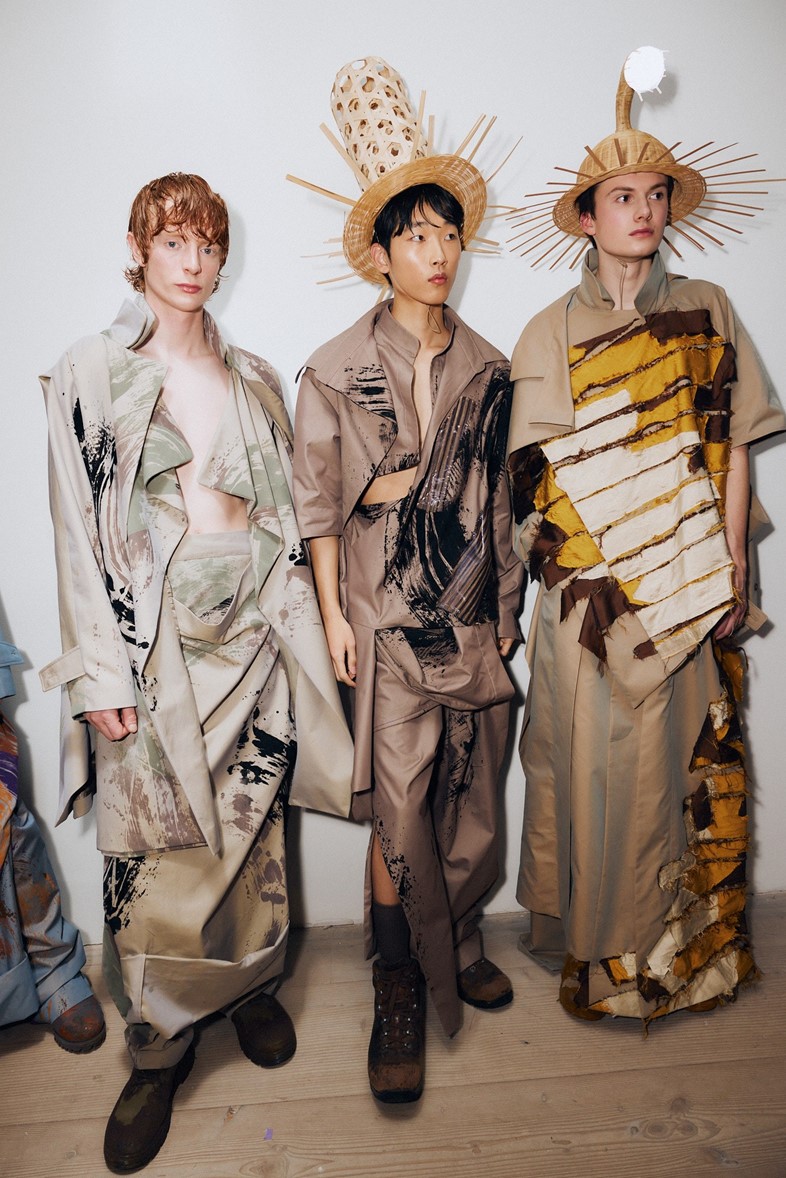
“Can I wear my hat?” beamed Zihan Miracle Liu backstage, when we asked him to take part in this interview. The energy and verve that Liu approached us with had just been joyously displayed on the runway, when the designer sent out a succession of deconstructed trench coats decorated with artistic swirls of paint, and then flocked with a heat transfer vinyl to give the colours a fuzzy texture. The collection had been inspired by Liu owns travels across Europe “in search of meaning and freedom” where he also honed his photographic process into a charming book of self-portraits where he lay on the floor in various beaches, roads and town squares across the continent. Back on the LFW catwalk, Liu’s trench coats were accessorised with intricately constructed bamboo hats from his native China, and one even had a light bulb in it that illuminated onlookers’ smiles as it hit the runway.
Scroll through the galleries at the top of this page to see all 18 collections from the CSM MA show.
in HTML format, including tags, to make it appealing and easy to read for Japanese-speaking readers aged 20 to 40 interested in fashion. Organize the content with appropriate headings and subheadings (h1, h2, h3, h4, h5, h6), translating all text, including headings, into Japanese. Retain any existing
tags from
Central Saint Martins MA Fashion 2025 – Part 144 Images
By now, you don’t need a reminder of why Central Saint Martins’ MA show is an important one on the calendar. The birthplace of countless design legends (Philo, Galliano, McQueen, etc), the university’s annual Masters showcase attracts one of the biggest and most fervent crowds at London Fashion Week, concluding the opening night of the schedule with a mammoth show of 18 collections, 140 looks and guests packed to the rafters. From lads in tea towels, to lunatic office sirens and blown-up Y-fronts, last night’s show had it all – so scroll down for eight of the best collections to have on your radar now.
Central Saint Martins MA Fashion 2025 – Part 245 Images

Alison Keogh and Kate Dewar met on the BA Fashion course at CSM and got on so well they decided to team up for their Masters degrees. “We did the second year group project in BA, where you either hate everyone you work with or you actually find something that works,” said New Zealand-born Keogh backstage, “and we’re just best friends!”
The pair’s collection shone on the runway for its uncanny simplicity, in that the clothes were quotidian, but rendered in unexpected fabrications that instantly elevated them to fashion. “We essentially started off with mundane everyday garments, and kind of wanted to take menswear into a surreal, hyperrealistic world through fabrication and colour,” said Scot Kate Dewar of the collection’s starting point. After gathering their references, the pair churned their research through an AI blender that produced glossy, high-shine outfits, then they went about recreating those as faithfully as they could. As a result, polo shirts were created in sky blue latex, silk trousers pooled at uncanny, latex-covered shoes, while plastic bangles were made to look like buttoned shirt cuffs. With those accessories, and the collection as a whole, Dewar added that the duo were “playing with the idea of what’s real and what isn’t, because we started off with research that was super ordinary, and turned it into like really odd imagery.”

British Fashion Council scholar and resident lad William Palmer also debuted his collection on Thursday night, where his aim was to present a “carefree and sensitive kind of guy” through playful subversions of Great British staples. Chequered teatowels were repurposed into baggy skater boy shirts, a waxy picnic blanket became a cagoule, a red teapot was a man-bag and teacups were transformed into bucket hats. “I’m very interested in lad culture,” Palmer told us backstage, “so I like reworking ‘lad’ garments with a funny twist.”
The designer – who used to work at Commes des Garçons – also parodied the financial pressures put on millennial and Gen Z men with his ‘breadwinner’ concept, sending a huge duffel bag in the shape of a loaf of bread down the runway, a big bite taken out of it to symbolise capitalist greed. Elsewhere, a businessman in a trench coat looked like he’d had the back of his boxer shorts hiked over his head, but it was actually an all-in-one wedgie playsuit. “I was drawing parallels between adolescence and adulthood with the wedgie,” said Palmer. “How kids assert dominance in the playground, and how that translates into the working world.” And it’s not only the BFC that Palmer has on side – last night he was announced as one of the winners of the L’Oréal Professionnel Award at the end of the show, finding out just before he had to his runway lap. “I’m actually so overwhelmed I didn’t know how to react,” he told us, afterwards. “I never win anything!”

“The collection is about trying to find joy in the future that feels a bit uncertain,” Jake Zhang told us after the show’s finale. “It’s about how we all have these digital escapes, like video games, cartoons. Instead of trying to escape with them, how do we bring them into the everyday?” At the show, Zhang brought those references into the everyday, by presenting avatars straight from a screen. Cropped sweaters and panelled hoodies emphasised action figure proportions, while floppy, cartoonish hats were placed on some models’ heads.
Along with the digital references, the collection was also referencing a kind of queer masculinity and desire, encoded in the scally sweatpants, bare chests and tight micro shorts. One garment that made everyone at the show reach into their trousers and whip out their iPhones was a pair of blown-up padded, Y-fronts, snapped on like Polly Pocket’s clothes. “They were inspired by old boxing shorts,” said Zhang, of the pair. “Vintage sportswear – particularly vintage boxing and bodybuilding – is so that man who is attractive without being intimidating. There’s something so camp and queer about him, even though he’s totally, probably straight.”

A Central Saint Martins fashion show is never short of its madcap, kaleidoscopic moments, and Scar Kennedy was on hand to provide the goods this year. The Leicestershire native’s MA collection Personality Hire was an absurd take on the office siren trend that has seemed to dominate our feeds for the last couple of years. “She’s kind of an office siren, but also like a lunatic,” the designer said of the Scar Kennedy woman. “She’s a menace to society, she’s chaotic, colourful, and tried to reflect that [in the collection].”
On the catwalk, a bulging, burnt orange Fair Isle cardigan was adorned with glittery pom poms, as were the maroon tights and peep-toe heels. A striped dress seemed to be distorted by ruching, but Kennedy had actually stitched old telephone cords into the fabric to give it a warped effect. Though she’s had stints working with Paulina Russo and Alicia Robinson of AGR Knit, Kennedy’s most immediate influence is eclectic Northerner Matty Bovan, who she described as “one of my biggest mentors” backstage.

New York native Kelechi Mpamaugo swapped the advertising world for the halls of CSM, having worked as an art director for brands like adidas and Ford before taking up her MA. Her LFW collection, Home and World, was inspired by a dual Black American and Nigerian heritage and the “constant movement between these worlds”. On the catwalk, signifiers from both cultures were spliced into hybrid avatars and offered up as a harmonious fusion. A model wearing a gele – a traditional Nigerian headdress – wore maroon cargo pants and gold sneakers below, while a bomber jacket was slashed into the shape of an agbada, a type of West African robe.
Elsewhere, double-sided football scarves draped across shoulders referenced both Igbo robes and America’s sporting culture, while a New Yorker in classic Timbs wore a pair of cargo shorts that had their own built-in sag. “The collection explores how tradition and modernity coexist within me and within so many others,” Mpamaugo told us. “From the deep-rooted traditions of West African dress, to the cool and athleticism embedded in Black American style, this collection is a tribute to the ways we navigate, adapt, and shape culture globally.”

After joining straight from the Fashion Design BA, Jane Fu’s debuted an MA collection centred on “the figure of the ‘hunter’ – someone who seeks, explores, and pursues.” A technical collection inspired by her native Inner Mongolia and its nomadic culture, Fu also added that the offering “world-builds around urban space as the new artificial nature, revealing a hybrid of urban tailoring and outdoor apparel.”
A model in a grey felt, panelled jacket appeared on the runway first, followed by more models in angular garments made of lightweight tech fabric. Though small, the collection was an expert combination of complicated construction and structured simplicity, with some garments made of composite shapes and fabrications, while others came unadorned. A standout were the padded cargo trousers with pop-out panels, which are sure to catch the eye of Stone Island, who offered Fu a job before she decided to go for the MA instead.

Last summer, designer Lucas Moretti had been reading SCUM Manifesto by Valerie Solanas and The Faggots & Their Friends Between Revolutions by Larry Mitchell. Those blistering, feminist declarations came to influence Moretti’s MA collection we saw last night, which was centred on his aesthetic rendering of the “motherly figure”. But, in Moretti’s world, the mother is a chic figure dressed in all black, whether that be hooded knitwear, a sequined gown, or a greatcoat constructed from wax cord strings. “Coming from Geneva, going to London, it was quite a shock,” said the designer. “It was really important for me to surround myself with female figures that could really empower me and also be friends and be mothers without being my mother.” Elsewhere in the collection, the wax strings reappeared as a handbag, while black wellies were repurposed into imposing, cunty heels. How can you not say mother!

“Can I wear my hat?” beamed Zihan Miracle Liu backstage, when we asked him to take part in this interview. The energy and verve that Liu approached us with had just been joyously displayed on the runway, when the designer sent out a succession of deconstructed trench coats decorated with artistic swirls of paint, and then flocked with a heat transfer vinyl to give the colours a fuzzy texture. The collection had been inspired by Liu owns travels across Europe “in search of meaning and freedom” where he also honed his photographic process into a charming book of self-portraits where he lay on the floor in various beaches, roads and town squares across the continent. Back on the LFW catwalk, Liu’s trench coats were accessorised with intricately constructed bamboo hats from his native China, and one even had a light bulb in it that illuminated onlookers’ smiles as it hit the runway.
Scroll through the galleries at the top of this page to see all 18 collections from the CSM MA show.
and integrate them seamlessly into the new content without adding new tags. Ensure the new content is fashion-related, written entirely in Japanese, and approximately 1500 words. Conclude with a “結論” section and a well-formatted “よくある質問” section. Avoid including an introduction or a note explaining the process.


